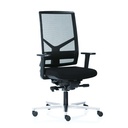Office Chairs
A good office chair is a vital tool for the office worker and choosing the most appropriate office furniture is critical at office fit out stage.
We are often asked what standards should office chairs comply with in Ireland.
As a minimum requirement all office chairs in Ireland have to comply with the dimensional requirements of BS EN 1335 Part 1.
This does not help the customer differentiate between the different ranges of office seating available.
This is particularly true nowadays as practically every office chair on the market is referred to as ergonomic office chairs, regardless of whether they deserve the ergonomic chair title or not.
At KOS Ergonomic Solutions, specilists in office chairs in Dublin and throughout Ireland, we divide office chairs into three categories:
Type A
Type B
Type C
Office work chair - Type A
Type A Chairs must have the following functions:
Seat depth shall be adjustable.
The seat inclination must be adjustable by at least six degrees.
Seat height shall be 400mm minimum and the adjustment range should be at least 120mm.
Adjustments of the backrest are independent of the seat surface.
Armrests should be adjustable in height, depth and width.
We further subdivide this category into three further categories:
Ergonomic chairs - this chair is ideal where high performance is required and budgets are not a limiting factor. These chairs allow for active and dynamic sitting. Many organisations consider this category of chair in their efforts to increase workplace productivity and reduce absenteeism
These chairs are suitable as operator task chairs and executive office chairs.
Specialist Back Care Chairs.
These are sometimes referred to as Orthopaedic Office Chairs. These chairs are aimed at, but by no means exclusive to, people who suffer from back pain and various musculoskeletal disorders. They have to be adaptable to the size and weight of the user. Most importantly, they must offer customisable support to the lumbar area and neck area, if required. Most of these chairs surpass even Type A criteria
These chairs are suitable as operator chairs and executive chairs and organisations who wish to implement good preventative healthcare.
Chairs for Large and Small users.
Office Chairs for large people are chairs designed with the larger user in mind and must fit correctly and offer optimum support.
Chairs for Heavier People – where standard chairs are not suitable.
Bariatric Office Chairs can also fit into this category
Office Chairs for small people are chairs designed with the smaller user in mind and must fit correctly and offer optimum support
Office work chair - Type B
This is the most common office chair sometimes referred to as office task chairs. Type B chairs can have independent backrest adjustments in relation to the seat surface, but it is not compulsory.
The backrest should be adjustable in height to ensure the lumbar area is properly supported.
Armrests should be adjustable in height as a minimum requirement
Dimensionally, they are the same as type A chairs except for the minimum seat height, which is 420mm and the minimum seat height adjustment range, which is 100mm.
The mechanism should allow and promote movement but yet maintain constant support with the lumbar area.
Seat depth adjustment is optional.
Areas of use: Call centre chairs. General office fit out chairs
Office work chair - Type C
(As an ergonomic office products company, KOS Ergonomic Solutions does not recommend this type of chair for office use)
The type C chairs are dimensionally similar to the type A chairs, but can have:
Reduced seat height adjustment range (minimum adjustment range of 80mm instead of 100mm)
Extra long seat depth
No independent backrest tilt in relation to the seat
Arms are usually not adjustable and offer little if any support.
Type C chairs often tend to be very large chairs with bulky upholstery and limited adjustability. These chairs may or may not satisfy the minimum requirements of the VDU regulations.















